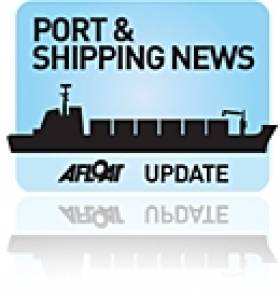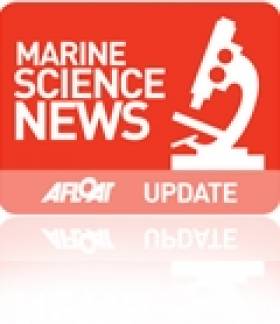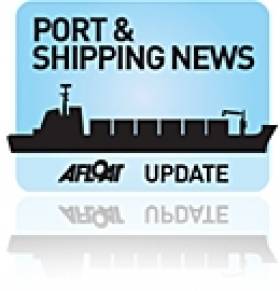Displaying items by tag: D'Amico
#PORTS & SHIPPING REVIEW – Over the last fortnight Jehan Ashmore reported the shipping scene which saw former Irish President Mary Robinson on board the National Geographic Explorer . She was a guest speaker during a 'Exploring the British Isles and Irish Isles' cruise.
An order for six 40,000 dwt bulk carrier newbuildings was placed by Irish based d'Amico Dry with China's Yangfan Group. D'Amico which is a fully owned subsidiary of the d'Amico group, has made the $134m deal, which values each handymax at $22.3m.
In advance of this weekend's visit of the London Olympic torch bearing tour to Ireland, the cruiseship Braemar called to Dublin Port. The vessel which was on a scheduled cruise is to be used as accommodation ship for key workers during the games for over a month, she is to moor close to the ExCEL Centre, which is to be used for a number of Olympic events.
On the ferry front the Isle of Man Steam Packet Company chartered the Arrow, a freight-ferry to cope with the increased volume in traffic associated with the famous annually held TT Races.
Along the south-west Irish coast, the small expedition cruiseship Clipper Odyssey made an anchorage call off Sneem on the Kenmare River. The 128 passenger vessel visited Co. Kerry having sailed the short distance from Cobh the previous day.
During the same week, two vessels met off Kilronan on Inishmore, Aran Islands. They were the cruiseship Island Sky which had started a cruise from Portsmouth and the lighthouse tender ILV Granuaile (2000/2,365grt) which is based in her homeport of Dun Laoghaire.
The last of the older Dublin Port tug fleet vessels Ben Eadar set sail on a delivery voyage for new owners in Portugal. While on the far side of the Irish Sea, the port of Liverpool welcomed its first turnaround cruise call in forty years in the form of Cruise & Maritime Voyages (CMV)'s Ocean Countess. However after leaving the Mersey, she suffered a temporary loss of engine power, forcing the vessel to turn around and divert to Holyhead.
Off the sunny south-east coast, the Expedition, a former Baltic Sea ferry converted to cruiseship duties anchored off the Saltee Islands. She sports a bright red hull still retained from her ferry owners, Viking Line, which the company choosed for their first ferry Apollo. Their choice in colour was found when one of the owner's relatives produced her lipstick!
Turning the corner at Carnsore Point and up to the boatyard of Arklow Marine Services where work on their latest newbuild Gardian 10 is nearing completion. The wind farm service vessel (WFSV) is due for launch later this month.
Taoiseach Announces Marine Jobs On Visit of RV Celtic Explorer
An Taoiseach Enda Kenny visited the Marine Institute's research vessel RV Celtic Explorer in Dublin Port today, where he announced the creation of 92 jobs in the marine sector, writes Jehan Ashmore.
"Ireland is now recognised as an emerging power in Marine Research and Innovation," said the Taoiseach. Of the new positions, 64 will be generated in the seafood processing sector. This follows a €3.5m Seafood Processing Business Investment Scheme administered by Bord Iascaigh Mhara (BIM). In the area of marine research, 28 jobs have been created through funding of €2m from an International SmartOcean Graduate Programme.
SmartOcean is a collaboration between IRCSET (Irish Research Council for Science Engineering and Technology), the Marine Institute, five Irish universities and key multinationals and SME Information and Communication Technology (ICT) companies to provide funding for 28 research posts.
The Taoiseach said: "This has been achieved through the mapping of the 90% of Irish national territory that lies under the Atlantic, the creation of a quarter of a billion Euros worth of marine research infrastructure, and the fostering of strong linkages between industry and research centres, all of which will support employment opportunities in key areas of potential growth in the marine sector."
During the tour of the RV Celtic Explorer, the Taoiseach who was accompanied by Minister for Agriculture, Marine and Food, Simon Coveney, welcomed the expansion of Ireland's capabilities in the international shipping services sector, which is expected to attract additional jobs to the country.
Ireland's emerging international shipping services sector has continued to grow, underpinned by a number of investments in new and second hand ships over the last twelve months by such companies as Arklow Shipping and the Mainport Group, as well as foreign direct investments by D'Amico and Ardmore shipping.
As reported on Afloat.ie, RV Celtic Explorer had arrived yesterday into Dublin Port, having completed a fisheries demersal survey which started in Galway on 23 September. Initially she had docked at Ocean Pier but she subsequently shifted berths to Sir John Rogersons Quay for today's reception of An Taoiseach. According to her survey schedule she is due to depart tomorrow on a herring acoustic survey which is to take place in the Celtic Sea and off the south-west coast.
- Dublin Port
- BIM
- Marine Institute
- marine science
- Arklow Shipping Ltd
- Bord Iascaigh Mhara
- Ports and Shipping News
- Ardmore Shipping
- Mainport Group
- D'Amico
- Irish marine jobs
- An Taoiseach Enda Kenny
- SmartOcean
- RV Celtic Explorer
- RV Celtic Voyager
- Sir John Rogersons Quay
- Irish research vessels
- Simon Coveney
The act is designed to assist in securing the future of the Irish shipping sector in which five new companies in 2010 entered the scheme, generating an increase of 44% in the number of vessels (from 154 to 177) covered by the Tonnage Tax. Half of these vessels range less than five years old with the total average age at eight years.
In addition the initiative has directly created 314 jobs in 2009 to nearly 350 jobs last year. Most of the employment is in specialised areas such finance,technical management, operations and chartering.
Commenting on the data, IMDO Director Glenn Murphy said "The results are a positive indication that after long periods of decline for the industry that policy support measures have encouraged investment which has led to growth and new employment. We are optimistic that direct employment
in the high value professional shipping services sector could double over the next five years leading to further investment and job creation opportunities"
The majority of Irish-based ship-owning firms operating within the ITT scheme are not entirely reliant on the Irish economy for their daily core revenue streams but are instead employed in the international shipping markets.
In 2010 the global shipping business had total charter trading transactions estimated at $450 billion dollars. It was a year in which the shipping markets continued to be quite volatile with most sectors still recovering from large charter earnings declines over the previous 12 months. Overall Irish firms were quite resilient in their ability to compete last year.
The growth in this sector in Ireland has been driven by established Irish-owned companies Arklow Shipping Ltd (ASL) and the Mainport Group and inward investment has come from D'Amico and Ardmore Shipping. The chemical and products tanker fleet operator located its headquarters to Cork last year and the company is backed by a large US private equity firm.
To read more from the report, you can request a copy by contacting the IMDO by e-mailing [email protected]


























































